Sustainable Energy Consumption - PDF
VerifiedAdded on 2021/01/02
|15
|4980
|387
AI Summary
Contribute Materials
Your contribution can guide someone’s learning journey. Share your
documents today.
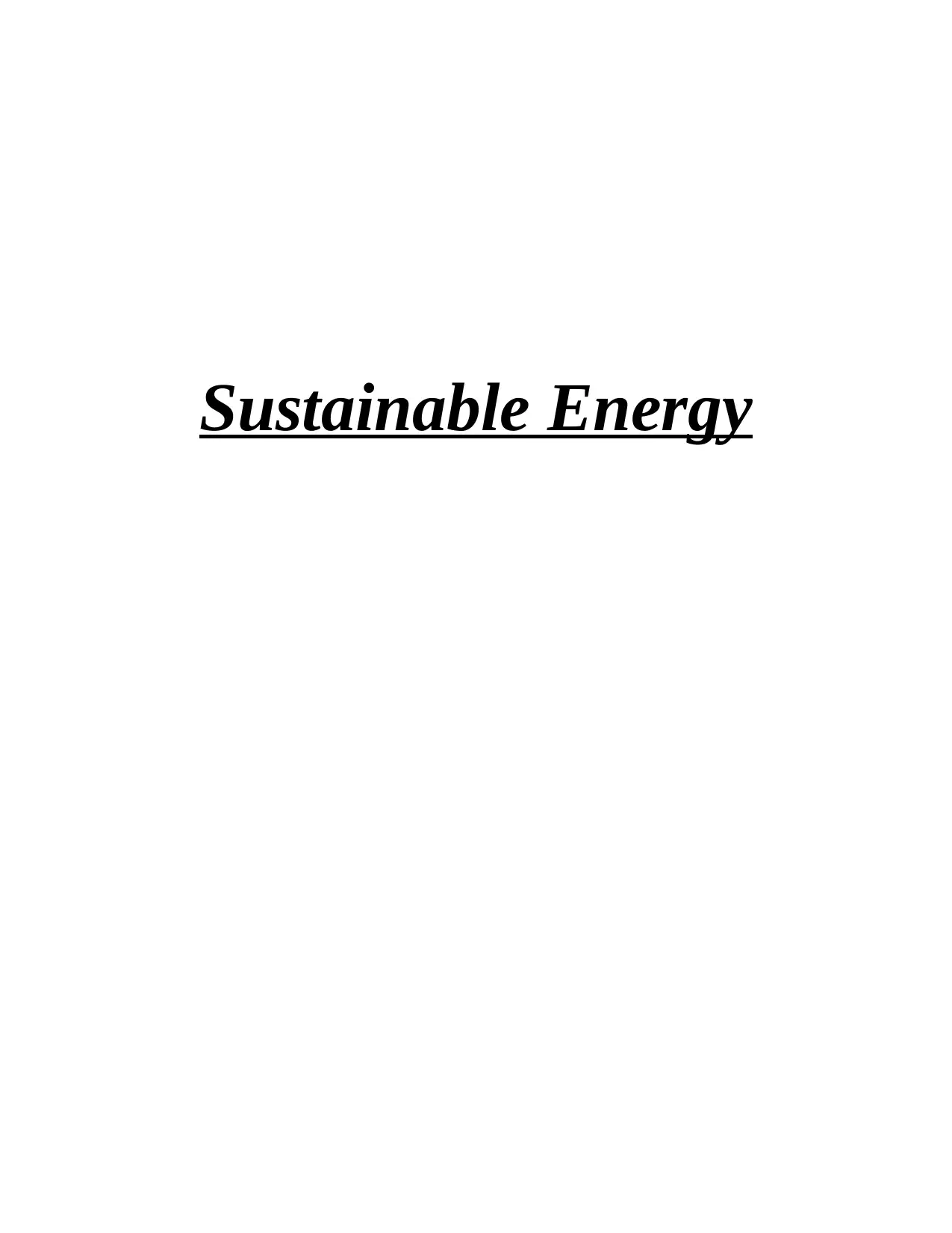
Sustainable Energy
Secure Best Marks with AI Grader
Need help grading? Try our AI Grader for instant feedback on your assignments.
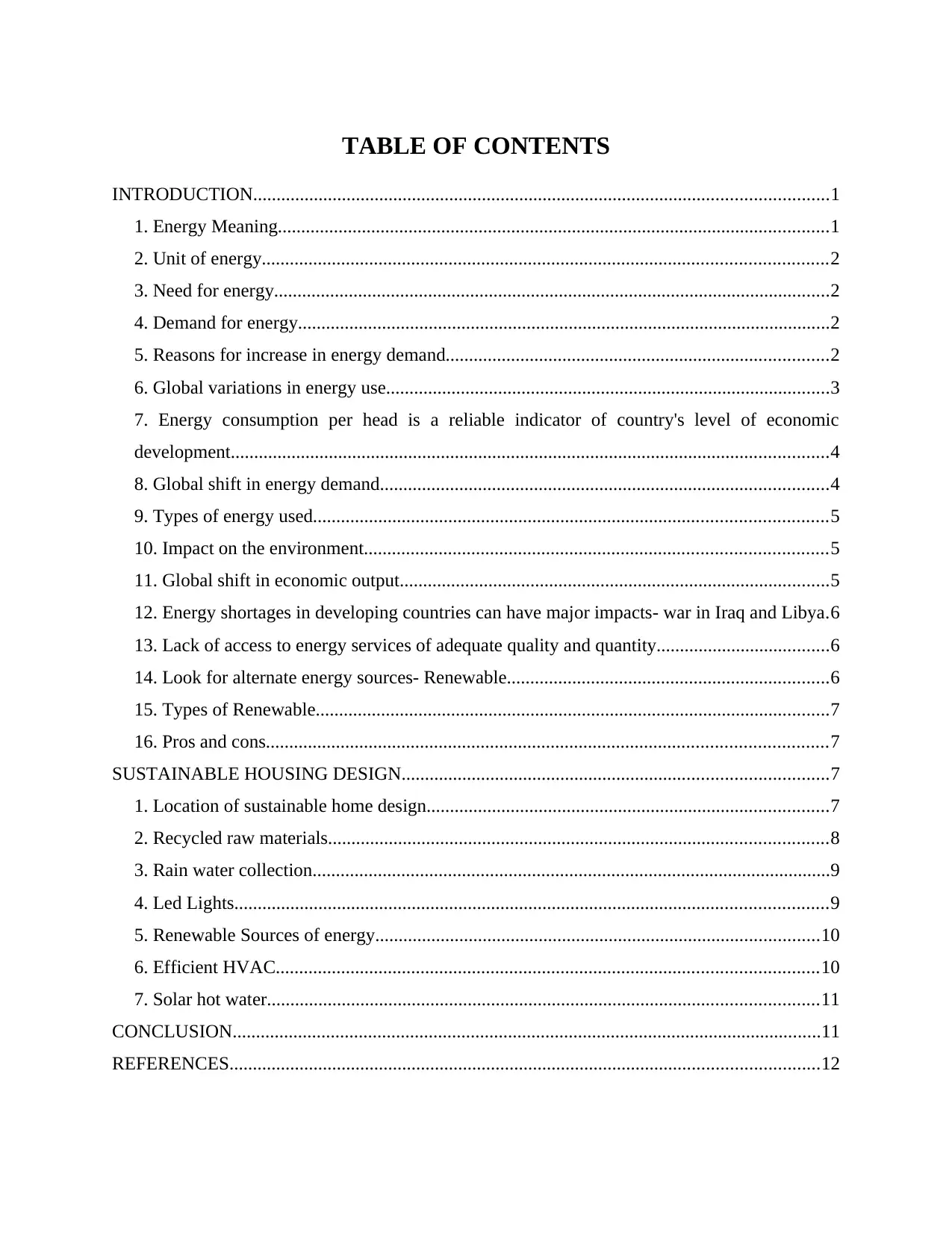
TABLE OF CONTENTS
INTRODUCTION...........................................................................................................................1
1. Energy Meaning......................................................................................................................1
2. Unit of energy.........................................................................................................................2
3. Need for energy.......................................................................................................................2
4. Demand for energy..................................................................................................................2
5. Reasons for increase in energy demand..................................................................................2
6. Global variations in energy use...............................................................................................3
7. Energy consumption per head is a reliable indicator of country's level of economic
development................................................................................................................................4
8. Global shift in energy demand................................................................................................4
9. Types of energy used..............................................................................................................5
10. Impact on the environment...................................................................................................5
11. Global shift in economic output............................................................................................5
12. Energy shortages in developing countries can have major impacts- war in Iraq and Libya.6
13. Lack of access to energy services of adequate quality and quantity.....................................6
14. Look for alternate energy sources- Renewable.....................................................................6
15. Types of Renewable..............................................................................................................7
16. Pros and cons........................................................................................................................7
SUSTAINABLE HOUSING DESIGN...........................................................................................7
1. Location of sustainable home design......................................................................................7
2. Recycled raw materials...........................................................................................................8
3. Rain water collection...............................................................................................................9
4. Led Lights...............................................................................................................................9
5. Renewable Sources of energy...............................................................................................10
6. Efficient HVAC....................................................................................................................10
7. Solar hot water......................................................................................................................11
CONCLUSION..............................................................................................................................11
REFERENCES..............................................................................................................................12
INTRODUCTION...........................................................................................................................1
1. Energy Meaning......................................................................................................................1
2. Unit of energy.........................................................................................................................2
3. Need for energy.......................................................................................................................2
4. Demand for energy..................................................................................................................2
5. Reasons for increase in energy demand..................................................................................2
6. Global variations in energy use...............................................................................................3
7. Energy consumption per head is a reliable indicator of country's level of economic
development................................................................................................................................4
8. Global shift in energy demand................................................................................................4
9. Types of energy used..............................................................................................................5
10. Impact on the environment...................................................................................................5
11. Global shift in economic output............................................................................................5
12. Energy shortages in developing countries can have major impacts- war in Iraq and Libya.6
13. Lack of access to energy services of adequate quality and quantity.....................................6
14. Look for alternate energy sources- Renewable.....................................................................6
15. Types of Renewable..............................................................................................................7
16. Pros and cons........................................................................................................................7
SUSTAINABLE HOUSING DESIGN...........................................................................................7
1. Location of sustainable home design......................................................................................7
2. Recycled raw materials...........................................................................................................8
3. Rain water collection...............................................................................................................9
4. Led Lights...............................................................................................................................9
5. Renewable Sources of energy...............................................................................................10
6. Efficient HVAC....................................................................................................................10
7. Solar hot water......................................................................................................................11
CONCLUSION..............................................................................................................................11
REFERENCES..............................................................................................................................12
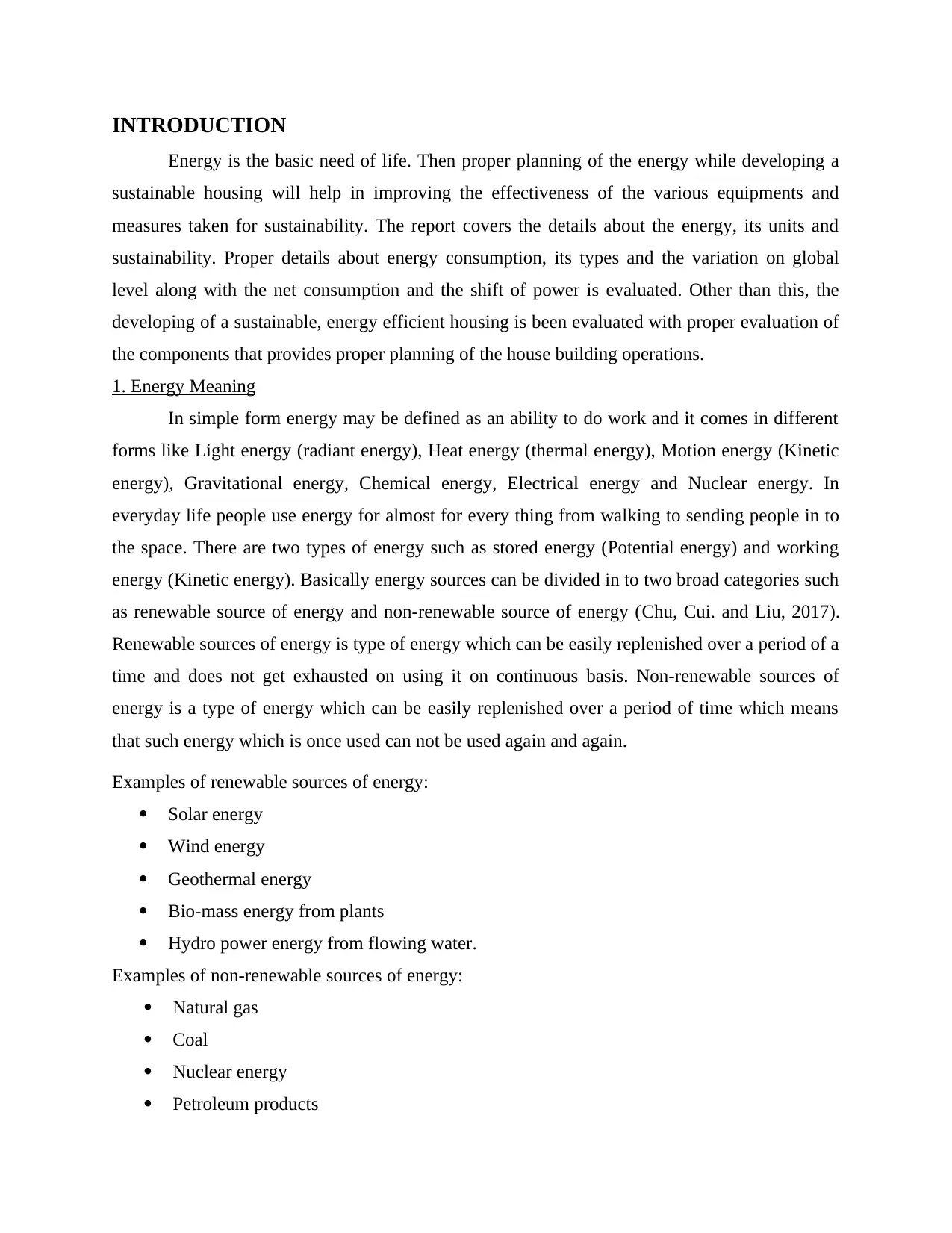
INTRODUCTION
Energy is the basic need of life. Then proper planning of the energy while developing a
sustainable housing will help in improving the effectiveness of the various equipments and
measures taken for sustainability. The report covers the details about the energy, its units and
sustainability. Proper details about energy consumption, its types and the variation on global
level along with the net consumption and the shift of power is evaluated. Other than this, the
developing of a sustainable, energy efficient housing is been evaluated with proper evaluation of
the components that provides proper planning of the house building operations.
1. Energy Meaning
In simple form energy may be defined as an ability to do work and it comes in different
forms like Light energy (radiant energy), Heat energy (thermal energy), Motion energy (Kinetic
energy), Gravitational energy, Chemical energy, Electrical energy and Nuclear energy. In
everyday life people use energy for almost for every thing from walking to sending people in to
the space. There are two types of energy such as stored energy (Potential energy) and working
energy (Kinetic energy). Basically energy sources can be divided in to two broad categories such
as renewable source of energy and non-renewable source of energy (Chu, Cui. and Liu, 2017).
Renewable sources of energy is type of energy which can be easily replenished over a period of a
time and does not get exhausted on using it on continuous basis. Non-renewable sources of
energy is a type of energy which can be easily replenished over a period of time which means
that such energy which is once used can not be used again and again.
Examples of renewable sources of energy:
Solar energy
Wind energy
Geothermal energy
Bio-mass energy from plants
Hydro power energy from flowing water.
Examples of non-renewable sources of energy:
Natural gas
Coal
Nuclear energy
Petroleum products
Energy is the basic need of life. Then proper planning of the energy while developing a
sustainable housing will help in improving the effectiveness of the various equipments and
measures taken for sustainability. The report covers the details about the energy, its units and
sustainability. Proper details about energy consumption, its types and the variation on global
level along with the net consumption and the shift of power is evaluated. Other than this, the
developing of a sustainable, energy efficient housing is been evaluated with proper evaluation of
the components that provides proper planning of the house building operations.
1. Energy Meaning
In simple form energy may be defined as an ability to do work and it comes in different
forms like Light energy (radiant energy), Heat energy (thermal energy), Motion energy (Kinetic
energy), Gravitational energy, Chemical energy, Electrical energy and Nuclear energy. In
everyday life people use energy for almost for every thing from walking to sending people in to
the space. There are two types of energy such as stored energy (Potential energy) and working
energy (Kinetic energy). Basically energy sources can be divided in to two broad categories such
as renewable source of energy and non-renewable source of energy (Chu, Cui. and Liu, 2017).
Renewable sources of energy is type of energy which can be easily replenished over a period of a
time and does not get exhausted on using it on continuous basis. Non-renewable sources of
energy is a type of energy which can be easily replenished over a period of time which means
that such energy which is once used can not be used again and again.
Examples of renewable sources of energy:
Solar energy
Wind energy
Geothermal energy
Bio-mass energy from plants
Hydro power energy from flowing water.
Examples of non-renewable sources of energy:
Natural gas
Coal
Nuclear energy
Petroleum products
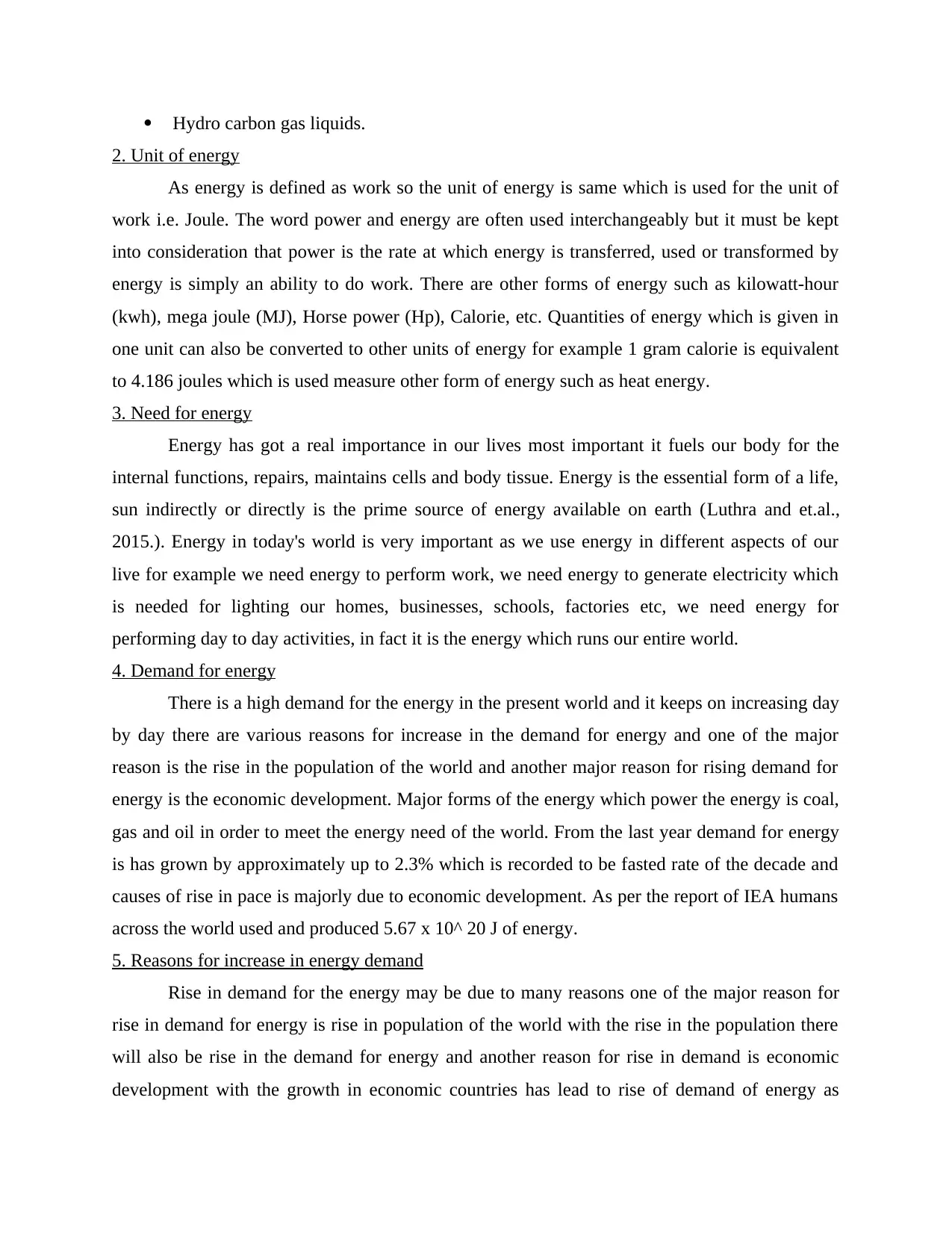
Hydro carbon gas liquids.
2. Unit of energy
As energy is defined as work so the unit of energy is same which is used for the unit of
work i.e. Joule. The word power and energy are often used interchangeably but it must be kept
into consideration that power is the rate at which energy is transferred, used or transformed by
energy is simply an ability to do work. There are other forms of energy such as kilowatt-hour
(kwh), mega joule (MJ), Horse power (Hp), Calorie, etc. Quantities of energy which is given in
one unit can also be converted to other units of energy for example 1 gram calorie is equivalent
to 4.186 joules which is used measure other form of energy such as heat energy.
3. Need for energy
Energy has got a real importance in our lives most important it fuels our body for the
internal functions, repairs, maintains cells and body tissue. Energy is the essential form of a life,
sun indirectly or directly is the prime source of energy available on earth (Luthra and et.al.,
2015.). Energy in today's world is very important as we use energy in different aspects of our
live for example we need energy to perform work, we need energy to generate electricity which
is needed for lighting our homes, businesses, schools, factories etc, we need energy for
performing day to day activities, in fact it is the energy which runs our entire world.
4. Demand for energy
There is a high demand for the energy in the present world and it keeps on increasing day
by day there are various reasons for increase in the demand for energy and one of the major
reason is the rise in the population of the world and another major reason for rising demand for
energy is the economic development. Major forms of the energy which power the energy is coal,
gas and oil in order to meet the energy need of the world. From the last year demand for energy
is has grown by approximately up to 2.3% which is recorded to be fasted rate of the decade and
causes of rise in pace is majorly due to economic development. As per the report of IEA humans
across the world used and produced 5.67 x 10^ 20 J of energy.
5. Reasons for increase in energy demand
Rise in demand for the energy may be due to many reasons one of the major reason for
rise in demand for energy is rise in population of the world with the rise in the population there
will also be rise in the demand for energy and another reason for rise in demand is economic
development with the growth in economic countries has lead to rise of demand of energy as
2. Unit of energy
As energy is defined as work so the unit of energy is same which is used for the unit of
work i.e. Joule. The word power and energy are often used interchangeably but it must be kept
into consideration that power is the rate at which energy is transferred, used or transformed by
energy is simply an ability to do work. There are other forms of energy such as kilowatt-hour
(kwh), mega joule (MJ), Horse power (Hp), Calorie, etc. Quantities of energy which is given in
one unit can also be converted to other units of energy for example 1 gram calorie is equivalent
to 4.186 joules which is used measure other form of energy such as heat energy.
3. Need for energy
Energy has got a real importance in our lives most important it fuels our body for the
internal functions, repairs, maintains cells and body tissue. Energy is the essential form of a life,
sun indirectly or directly is the prime source of energy available on earth (Luthra and et.al.,
2015.). Energy in today's world is very important as we use energy in different aspects of our
live for example we need energy to perform work, we need energy to generate electricity which
is needed for lighting our homes, businesses, schools, factories etc, we need energy for
performing day to day activities, in fact it is the energy which runs our entire world.
4. Demand for energy
There is a high demand for the energy in the present world and it keeps on increasing day
by day there are various reasons for increase in the demand for energy and one of the major
reason is the rise in the population of the world and another major reason for rising demand for
energy is the economic development. Major forms of the energy which power the energy is coal,
gas and oil in order to meet the energy need of the world. From the last year demand for energy
is has grown by approximately up to 2.3% which is recorded to be fasted rate of the decade and
causes of rise in pace is majorly due to economic development. As per the report of IEA humans
across the world used and produced 5.67 x 10^ 20 J of energy.
5. Reasons for increase in energy demand
Rise in demand for the energy may be due to many reasons one of the major reason for
rise in demand for energy is rise in population of the world with the rise in the population there
will also be rise in the demand for energy and another reason for rise in demand is economic
development with the growth in economic countries has lead to rise of demand of energy as
Secure Best Marks with AI Grader
Need help grading? Try our AI Grader for instant feedback on your assignments.
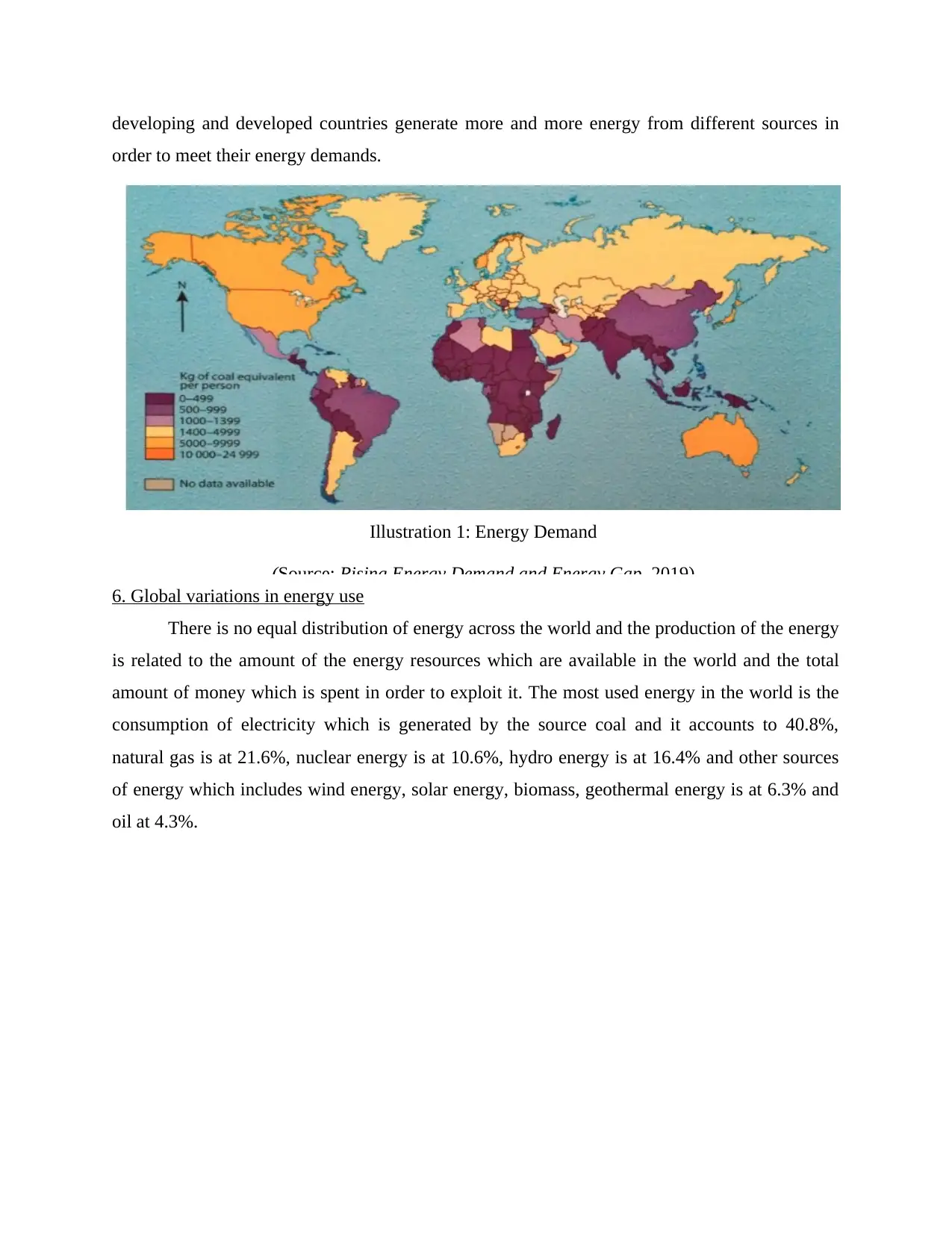
developing and developed countries generate more and more energy from different sources in
order to meet their energy demands.
6. Global variations in energy use
There is no equal distribution of energy across the world and the production of the energy
is related to the amount of the energy resources which are available in the world and the total
amount of money which is spent in order to exploit it. The most used energy in the world is the
consumption of electricity which is generated by the source coal and it accounts to 40.8%,
natural gas is at 21.6%, nuclear energy is at 10.6%, hydro energy is at 16.4% and other sources
of energy which includes wind energy, solar energy, biomass, geothermal energy is at 6.3% and
oil at 4.3%.
Illustration 1: Energy Demand
(Source: Rising Energy Demand and Energy Gap, 2019)
order to meet their energy demands.
6. Global variations in energy use
There is no equal distribution of energy across the world and the production of the energy
is related to the amount of the energy resources which are available in the world and the total
amount of money which is spent in order to exploit it. The most used energy in the world is the
consumption of electricity which is generated by the source coal and it accounts to 40.8%,
natural gas is at 21.6%, nuclear energy is at 10.6%, hydro energy is at 16.4% and other sources
of energy which includes wind energy, solar energy, biomass, geothermal energy is at 6.3% and
oil at 4.3%.
Illustration 1: Energy Demand
(Source: Rising Energy Demand and Energy Gap, 2019)
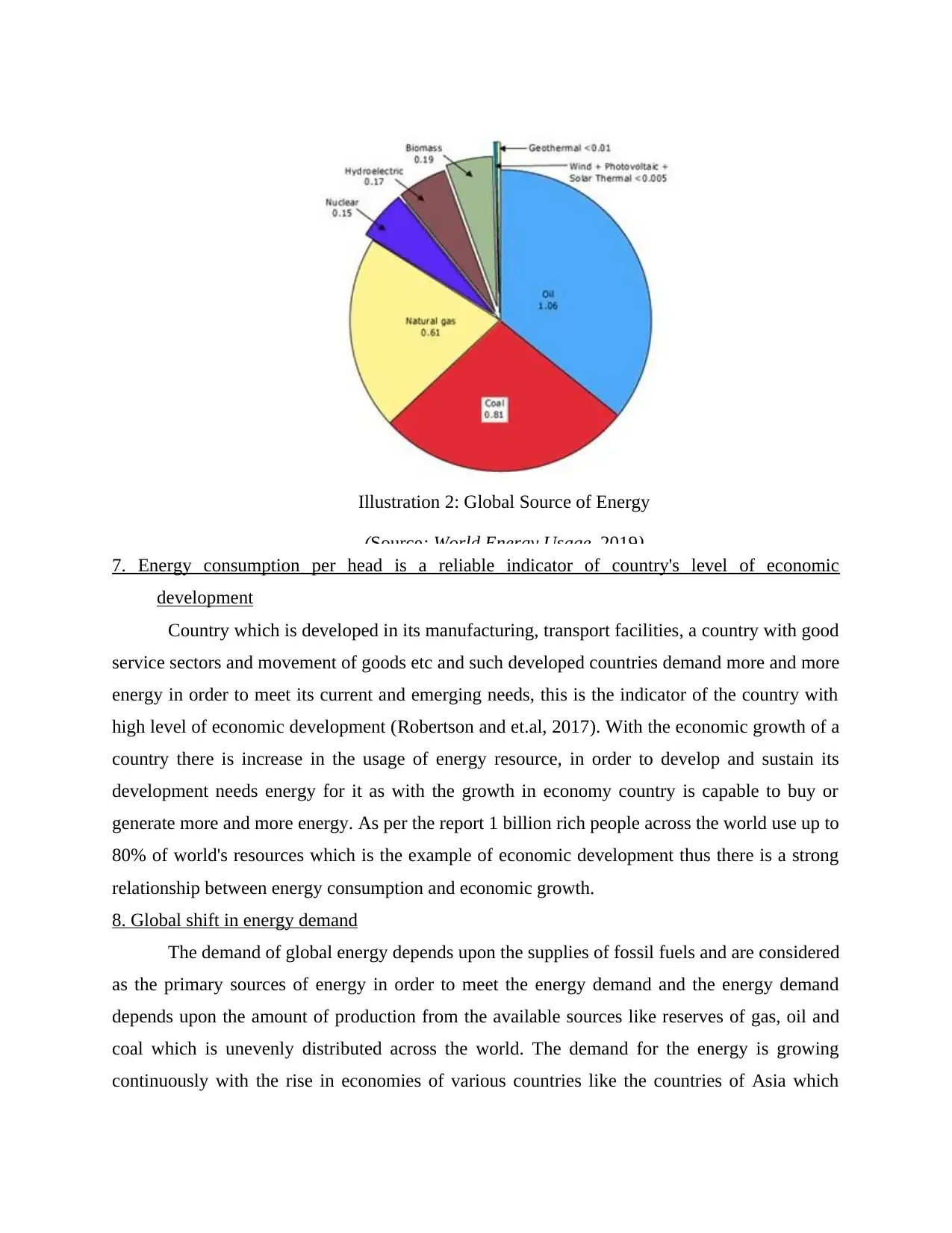
Illustration 2: Global Source of Energy
(Source: World Energy Usage, 2019)
7. Energy consumption per head is a reliable indicator of country's level of economic
development
Country which is developed in its manufacturing, transport facilities, a country with good
service sectors and movement of goods etc and such developed countries demand more and more
energy in order to meet its current and emerging needs, this is the indicator of the country with
high level of economic development (Robertson and et.al, 2017). With the economic growth of a
country there is increase in the usage of energy resource, in order to develop and sustain its
development needs energy for it as with the growth in economy country is capable to buy or
generate more and more energy. As per the report 1 billion rich people across the world use up to
80% of world's resources which is the example of economic development thus there is a strong
relationship between energy consumption and economic growth.
8. Global shift in energy demand
The demand of global energy depends upon the supplies of fossil fuels and are considered
as the primary sources of energy in order to meet the energy demand and the energy demand
depends upon the amount of production from the available sources like reserves of gas, oil and
coal which is unevenly distributed across the world. The demand for the energy is growing
continuously with the rise in economies of various countries like the countries of Asia which
(Source: World Energy Usage, 2019)
7. Energy consumption per head is a reliable indicator of country's level of economic
development
Country which is developed in its manufacturing, transport facilities, a country with good
service sectors and movement of goods etc and such developed countries demand more and more
energy in order to meet its current and emerging needs, this is the indicator of the country with
high level of economic development (Robertson and et.al, 2017). With the economic growth of a
country there is increase in the usage of energy resource, in order to develop and sustain its
development needs energy for it as with the growth in economy country is capable to buy or
generate more and more energy. As per the report 1 billion rich people across the world use up to
80% of world's resources which is the example of economic development thus there is a strong
relationship between energy consumption and economic growth.
8. Global shift in energy demand
The demand of global energy depends upon the supplies of fossil fuels and are considered
as the primary sources of energy in order to meet the energy demand and the energy demand
depends upon the amount of production from the available sources like reserves of gas, oil and
coal which is unevenly distributed across the world. The demand for the energy is growing
continuously with the rise in economies of various countries like the countries of Asia which

includes India, China and other developing countries where the economies is increasing and
people demand more and more energy.
9. Types of energy used
In present there are various types of energy used around the world and there are two main
categories of energy one is renewable sources of energy and non-renewable sources of energy.
Non-renewable sources of energy are type of energies which can not be renewed over a period
these energy resources once used can not be used again and again. Fossil fuels forms the major
source of energy, there are various type of fossil fuels which are used for the energy provisos
across the world like oil, natural gas and coal (Dusastre and Martiradonna, 2017). Natural gas is
present in the gaseous form and it is abundantly present in nature and is responsible for less
pollution as compared to other forms of fossil fuels. Coal is a type of a fossil fuel which formed
from decaying of vegetation and land over the years another form of fossil fuel is oil which is
present in the liquid form and is formed form the remains of micro-organisms deposited on the
sea floor.
10. Impact on the environment
Fossil fuels are one of the major reasons for environmental pollution in the world as
burning of fossil fuels have a huge impact on the world's environment. Burning of fossil fuels
results in release of carbon dioxide which is responsible for global warming and also results in
climate change (Cuce, Harjunowibowo and Cuce, 2016). Burning of fossil fuels and the
pollutants released from them results in adverse impact on the climate the pollutants like sulphur
dioxide emission results in acid rains. So, burning of fossil fuels have huge impact on global
environment.
11. Global shift in economic output
With the rise in globalisation and increase in industrialisation many developing countries
have increased their share in the world trade, this has become possible only due to globalisation.
From the last decade there has been a drastic shift in the balance of economies and financial
power of the global economy. More than 57% of global GDP is contributed by emerging
countries of the world, the countries like Japan, USA, Canada and European Countries account
to half of total global GDP and in coming years G7 countries will be able to share their total
GDP more than E7 countries due to economic development.
people demand more and more energy.
9. Types of energy used
In present there are various types of energy used around the world and there are two main
categories of energy one is renewable sources of energy and non-renewable sources of energy.
Non-renewable sources of energy are type of energies which can not be renewed over a period
these energy resources once used can not be used again and again. Fossil fuels forms the major
source of energy, there are various type of fossil fuels which are used for the energy provisos
across the world like oil, natural gas and coal (Dusastre and Martiradonna, 2017). Natural gas is
present in the gaseous form and it is abundantly present in nature and is responsible for less
pollution as compared to other forms of fossil fuels. Coal is a type of a fossil fuel which formed
from decaying of vegetation and land over the years another form of fossil fuel is oil which is
present in the liquid form and is formed form the remains of micro-organisms deposited on the
sea floor.
10. Impact on the environment
Fossil fuels are one of the major reasons for environmental pollution in the world as
burning of fossil fuels have a huge impact on the world's environment. Burning of fossil fuels
results in release of carbon dioxide which is responsible for global warming and also results in
climate change (Cuce, Harjunowibowo and Cuce, 2016). Burning of fossil fuels and the
pollutants released from them results in adverse impact on the climate the pollutants like sulphur
dioxide emission results in acid rains. So, burning of fossil fuels have huge impact on global
environment.
11. Global shift in economic output
With the rise in globalisation and increase in industrialisation many developing countries
have increased their share in the world trade, this has become possible only due to globalisation.
From the last decade there has been a drastic shift in the balance of economies and financial
power of the global economy. More than 57% of global GDP is contributed by emerging
countries of the world, the countries like Japan, USA, Canada and European Countries account
to half of total global GDP and in coming years G7 countries will be able to share their total
GDP more than E7 countries due to economic development.
Paraphrase This Document
Need a fresh take? Get an instant paraphrase of this document with our AI Paraphraser

12. Energy shortages in developing countries can have major impacts- war in Iraq and Libya
As developing countries are growing at a very fast pace and any shortage of resources
will hamper their development so, in order to fulfil their energy need they have to acquire energy
sources from the countries which are rich in such sources for example the war in Iraq and Libya
oil is the main purpose behind it and has led huge consequences on both the countries like killing
of innocent, loss of job, destruction of property, etc. War of oil also result in the conflicts in other
neighbouring countries like disallowing the flow of oil to international markets form the
countries of middle east.
13. Lack of access to energy services of adequate quality and quantity
Lack of access to energy services of good quality and quantity can have following impact
of countries such as:
It will have negative impact on country's dynamic growth as growth of a country totally
depends upon the energy services available for the country (Li and et.al., 2017).
It will also prevent the countries from developing inclusive societies, any society of a
country depends upon the growth and economic development of a nation but lack of
resources of energy can restrict the growth and development of societies.
This also hampers a country from improving its economic growth which can have
negative impact on the country's efforts in eradicating the poverty as country will not be
able to provide basic amenities to the people like water, electricity, petroleum products,
etc which will restrict the country from eradicating the poverty.
If the country is not provided with adequate energy service this will restrict the country in
providing suitable curative and preventive services to the people which will restrict health
services in reaching to needy people.
Lack of adequate resources will also hamper schooling and children's chances of escaping
poverty, because if country lacks the energy resources there will be less economic
development of the country which will restrict building of schools within the nation so
poor children will not be able to get proper education and this will restrict the children's
chances of escaping poverty.
14. Look for alternate energy sources- Renewable
With the rise in demand of energy, there has also been less sources of energy available
for example fossil fuels are at the verge of its extinction so, it has become important for the
As developing countries are growing at a very fast pace and any shortage of resources
will hamper their development so, in order to fulfil their energy need they have to acquire energy
sources from the countries which are rich in such sources for example the war in Iraq and Libya
oil is the main purpose behind it and has led huge consequences on both the countries like killing
of innocent, loss of job, destruction of property, etc. War of oil also result in the conflicts in other
neighbouring countries like disallowing the flow of oil to international markets form the
countries of middle east.
13. Lack of access to energy services of adequate quality and quantity
Lack of access to energy services of good quality and quantity can have following impact
of countries such as:
It will have negative impact on country's dynamic growth as growth of a country totally
depends upon the energy services available for the country (Li and et.al., 2017).
It will also prevent the countries from developing inclusive societies, any society of a
country depends upon the growth and economic development of a nation but lack of
resources of energy can restrict the growth and development of societies.
This also hampers a country from improving its economic growth which can have
negative impact on the country's efforts in eradicating the poverty as country will not be
able to provide basic amenities to the people like water, electricity, petroleum products,
etc which will restrict the country from eradicating the poverty.
If the country is not provided with adequate energy service this will restrict the country in
providing suitable curative and preventive services to the people which will restrict health
services in reaching to needy people.
Lack of adequate resources will also hamper schooling and children's chances of escaping
poverty, because if country lacks the energy resources there will be less economic
development of the country which will restrict building of schools within the nation so
poor children will not be able to get proper education and this will restrict the children's
chances of escaping poverty.
14. Look for alternate energy sources- Renewable
With the rise in demand of energy, there has also been less sources of energy available
for example fossil fuels are at the verge of its extinction so, it has become important for the
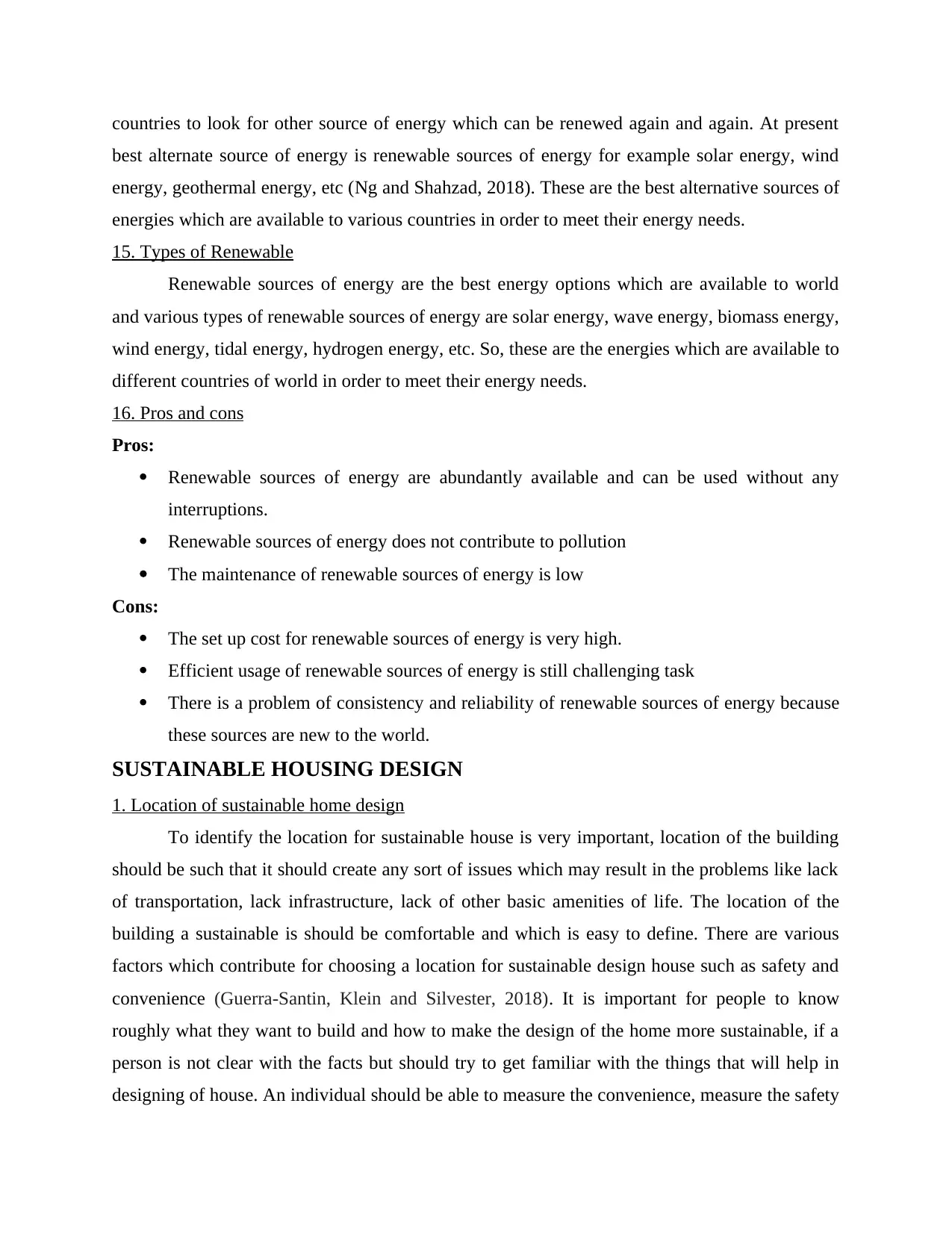
countries to look for other source of energy which can be renewed again and again. At present
best alternate source of energy is renewable sources of energy for example solar energy, wind
energy, geothermal energy, etc (Ng and Shahzad, 2018). These are the best alternative sources of
energies which are available to various countries in order to meet their energy needs.
15. Types of Renewable
Renewable sources of energy are the best energy options which are available to world
and various types of renewable sources of energy are solar energy, wave energy, biomass energy,
wind energy, tidal energy, hydrogen energy, etc. So, these are the energies which are available to
different countries of world in order to meet their energy needs.
16. Pros and cons
Pros:
Renewable sources of energy are abundantly available and can be used without any
interruptions.
Renewable sources of energy does not contribute to pollution
The maintenance of renewable sources of energy is low
Cons:
The set up cost for renewable sources of energy is very high.
Efficient usage of renewable sources of energy is still challenging task
There is a problem of consistency and reliability of renewable sources of energy because
these sources are new to the world.
SUSTAINABLE HOUSING DESIGN
1. Location of sustainable home design
To identify the location for sustainable house is very important, location of the building
should be such that it should create any sort of issues which may result in the problems like lack
of transportation, lack infrastructure, lack of other basic amenities of life. The location of the
building a sustainable is should be comfortable and which is easy to define. There are various
factors which contribute for choosing a location for sustainable design house such as safety and
convenience (Guerra-Santin, Klein and Silvester, 2018). It is important for people to know
roughly what they want to build and how to make the design of the home more sustainable, if a
person is not clear with the facts but should try to get familiar with the things that will help in
designing of house. An individual should be able to measure the convenience, measure the safety
best alternate source of energy is renewable sources of energy for example solar energy, wind
energy, geothermal energy, etc (Ng and Shahzad, 2018). These are the best alternative sources of
energies which are available to various countries in order to meet their energy needs.
15. Types of Renewable
Renewable sources of energy are the best energy options which are available to world
and various types of renewable sources of energy are solar energy, wave energy, biomass energy,
wind energy, tidal energy, hydrogen energy, etc. So, these are the energies which are available to
different countries of world in order to meet their energy needs.
16. Pros and cons
Pros:
Renewable sources of energy are abundantly available and can be used without any
interruptions.
Renewable sources of energy does not contribute to pollution
The maintenance of renewable sources of energy is low
Cons:
The set up cost for renewable sources of energy is very high.
Efficient usage of renewable sources of energy is still challenging task
There is a problem of consistency and reliability of renewable sources of energy because
these sources are new to the world.
SUSTAINABLE HOUSING DESIGN
1. Location of sustainable home design
To identify the location for sustainable house is very important, location of the building
should be such that it should create any sort of issues which may result in the problems like lack
of transportation, lack infrastructure, lack of other basic amenities of life. The location of the
building a sustainable is should be comfortable and which is easy to define. There are various
factors which contribute for choosing a location for sustainable design house such as safety and
convenience (Guerra-Santin, Klein and Silvester, 2018). It is important for people to know
roughly what they want to build and how to make the design of the home more sustainable, if a
person is not clear with the facts but should try to get familiar with the things that will help in
designing of house. An individual should be able to measure the convenience, measure the safety

which can help in choosing the best location for the sustainable house. There are various issues
which are to be considered while choosing a location such as:
One should try to avoid hazardous site and should try to choose a site which is safe to live
peacefully. If an individual chooses a site which is quite hazardous so, the building
should be able to withstand the hazards. There are two types of hazards which a house
should be able to with stand one is hazards from nature like floods, earthquake,
hurricanes, storms etc and another is man made hazards such as pollutions from factories,
vehicles, etc. so, the building should be able to stand against the hazardous situations
(Liu, Liu and Liu, Z., 2019) .
One should choose a location which should have suitable transportation facilities
available. Transportation facilities are very important for choosing a site of location of a
building as it will help in approaching various other services which are important like
emergency services. A location with good transportation facilities can also help in
movement of raw materials for the construction of the house.
Another issue which an individual has to overcome is availability of infrastructure and
utilities which are important for building a house. If an individual is able to use existing
infrastructure this is the best strategy for reducing the negative impact on the
environment (Stougie, Giustozzi and Stoppato, 2018).
2. Recycled raw materials
Recycling may be defined as the process of conversion of waste materials into new
materials and can be once again used. Using of recycled materials for the construction of
sustainable house can help in conservation of environment and energy resources. For the purpose
of construction of sustainable house using of recycling materials is the best strategy and it
depends up on the location for construction of house and availability of the resources will vary
from place to place (Fontes and Freires, 2018). One can use various type of recycled materials
for the construction of sustainable house and also there are various types of materials which can
be recycled and reused for the construction purpose. There are some materials which are
recycled can be used for building a sustainable house like steel which is made of recycled metals,
counter tops which are made up of recycled glass. Also, one can use reclaimed bricks and other
masonry items which can be used for the construction purposes. An individual can also use the
wood from the demolition sites for when any old house or building is demolished on can claim
which are to be considered while choosing a location such as:
One should try to avoid hazardous site and should try to choose a site which is safe to live
peacefully. If an individual chooses a site which is quite hazardous so, the building
should be able to withstand the hazards. There are two types of hazards which a house
should be able to with stand one is hazards from nature like floods, earthquake,
hurricanes, storms etc and another is man made hazards such as pollutions from factories,
vehicles, etc. so, the building should be able to stand against the hazardous situations
(Liu, Liu and Liu, Z., 2019) .
One should choose a location which should have suitable transportation facilities
available. Transportation facilities are very important for choosing a site of location of a
building as it will help in approaching various other services which are important like
emergency services. A location with good transportation facilities can also help in
movement of raw materials for the construction of the house.
Another issue which an individual has to overcome is availability of infrastructure and
utilities which are important for building a house. If an individual is able to use existing
infrastructure this is the best strategy for reducing the negative impact on the
environment (Stougie, Giustozzi and Stoppato, 2018).
2. Recycled raw materials
Recycling may be defined as the process of conversion of waste materials into new
materials and can be once again used. Using of recycled materials for the construction of
sustainable house can help in conservation of environment and energy resources. For the purpose
of construction of sustainable house using of recycling materials is the best strategy and it
depends up on the location for construction of house and availability of the resources will vary
from place to place (Fontes and Freires, 2018). One can use various type of recycled materials
for the construction of sustainable house and also there are various types of materials which can
be recycled and reused for the construction purpose. There are some materials which are
recycled can be used for building a sustainable house like steel which is made of recycled metals,
counter tops which are made up of recycled glass. Also, one can use reclaimed bricks and other
masonry items which can be used for the construction purposes. An individual can also use the
wood from the demolition sites for when any old house or building is demolished on can claim
Secure Best Marks with AI Grader
Need help grading? Try our AI Grader for instant feedback on your assignments.
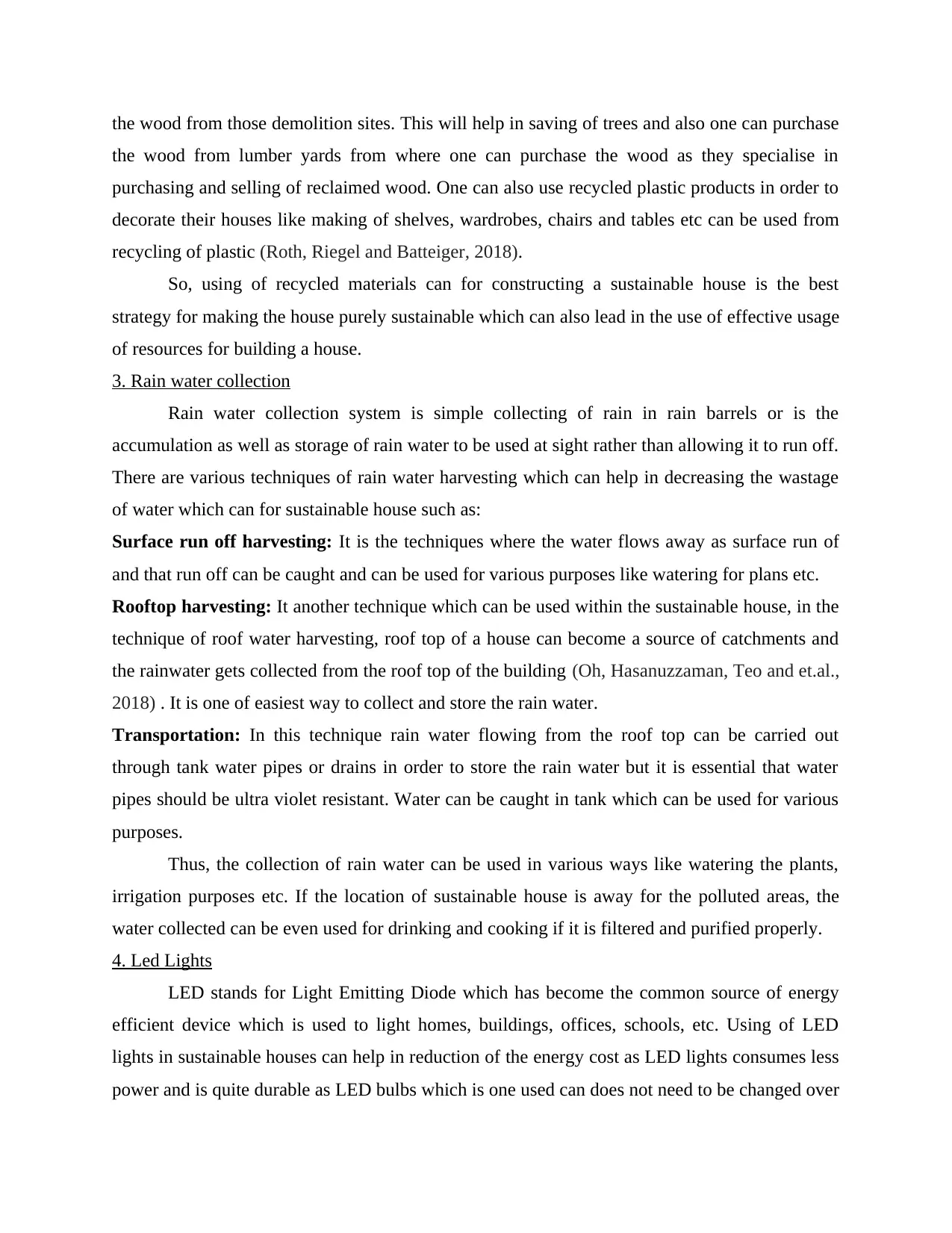
the wood from those demolition sites. This will help in saving of trees and also one can purchase
the wood from lumber yards from where one can purchase the wood as they specialise in
purchasing and selling of reclaimed wood. One can also use recycled plastic products in order to
decorate their houses like making of shelves, wardrobes, chairs and tables etc can be used from
recycling of plastic (Roth, Riegel and Batteiger, 2018).
So, using of recycled materials can for constructing a sustainable house is the best
strategy for making the house purely sustainable which can also lead in the use of effective usage
of resources for building a house.
3. Rain water collection
Rain water collection system is simple collecting of rain in rain barrels or is the
accumulation as well as storage of rain water to be used at sight rather than allowing it to run off.
There are various techniques of rain water harvesting which can help in decreasing the wastage
of water which can for sustainable house such as:
Surface run off harvesting: It is the techniques where the water flows away as surface run of
and that run off can be caught and can be used for various purposes like watering for plans etc.
Rooftop harvesting: It another technique which can be used within the sustainable house, in the
technique of roof water harvesting, roof top of a house can become a source of catchments and
the rainwater gets collected from the roof top of the building (Oh, Hasanuzzaman, Teo and et.al.,
2018) . It is one of easiest way to collect and store the rain water.
Transportation: In this technique rain water flowing from the roof top can be carried out
through tank water pipes or drains in order to store the rain water but it is essential that water
pipes should be ultra violet resistant. Water can be caught in tank which can be used for various
purposes.
Thus, the collection of rain water can be used in various ways like watering the plants,
irrigation purposes etc. If the location of sustainable house is away for the polluted areas, the
water collected can be even used for drinking and cooking if it is filtered and purified properly.
4. Led Lights
LED stands for Light Emitting Diode which has become the common source of energy
efficient device which is used to light homes, buildings, offices, schools, etc. Using of LED
lights in sustainable houses can help in reduction of the energy cost as LED lights consumes less
power and is quite durable as LED bulbs which is one used can does not need to be changed over
the wood from lumber yards from where one can purchase the wood as they specialise in
purchasing and selling of reclaimed wood. One can also use recycled plastic products in order to
decorate their houses like making of shelves, wardrobes, chairs and tables etc can be used from
recycling of plastic (Roth, Riegel and Batteiger, 2018).
So, using of recycled materials can for constructing a sustainable house is the best
strategy for making the house purely sustainable which can also lead in the use of effective usage
of resources for building a house.
3. Rain water collection
Rain water collection system is simple collecting of rain in rain barrels or is the
accumulation as well as storage of rain water to be used at sight rather than allowing it to run off.
There are various techniques of rain water harvesting which can help in decreasing the wastage
of water which can for sustainable house such as:
Surface run off harvesting: It is the techniques where the water flows away as surface run of
and that run off can be caught and can be used for various purposes like watering for plans etc.
Rooftop harvesting: It another technique which can be used within the sustainable house, in the
technique of roof water harvesting, roof top of a house can become a source of catchments and
the rainwater gets collected from the roof top of the building (Oh, Hasanuzzaman, Teo and et.al.,
2018) . It is one of easiest way to collect and store the rain water.
Transportation: In this technique rain water flowing from the roof top can be carried out
through tank water pipes or drains in order to store the rain water but it is essential that water
pipes should be ultra violet resistant. Water can be caught in tank which can be used for various
purposes.
Thus, the collection of rain water can be used in various ways like watering the plants,
irrigation purposes etc. If the location of sustainable house is away for the polluted areas, the
water collected can be even used for drinking and cooking if it is filtered and purified properly.
4. Led Lights
LED stands for Light Emitting Diode which has become the common source of energy
efficient device which is used to light homes, buildings, offices, schools, etc. Using of LED
lights in sustainable houses can help in reduction of the energy cost as LED lights consumes less
power and is quite durable as LED bulbs which is one used can does not need to be changed over
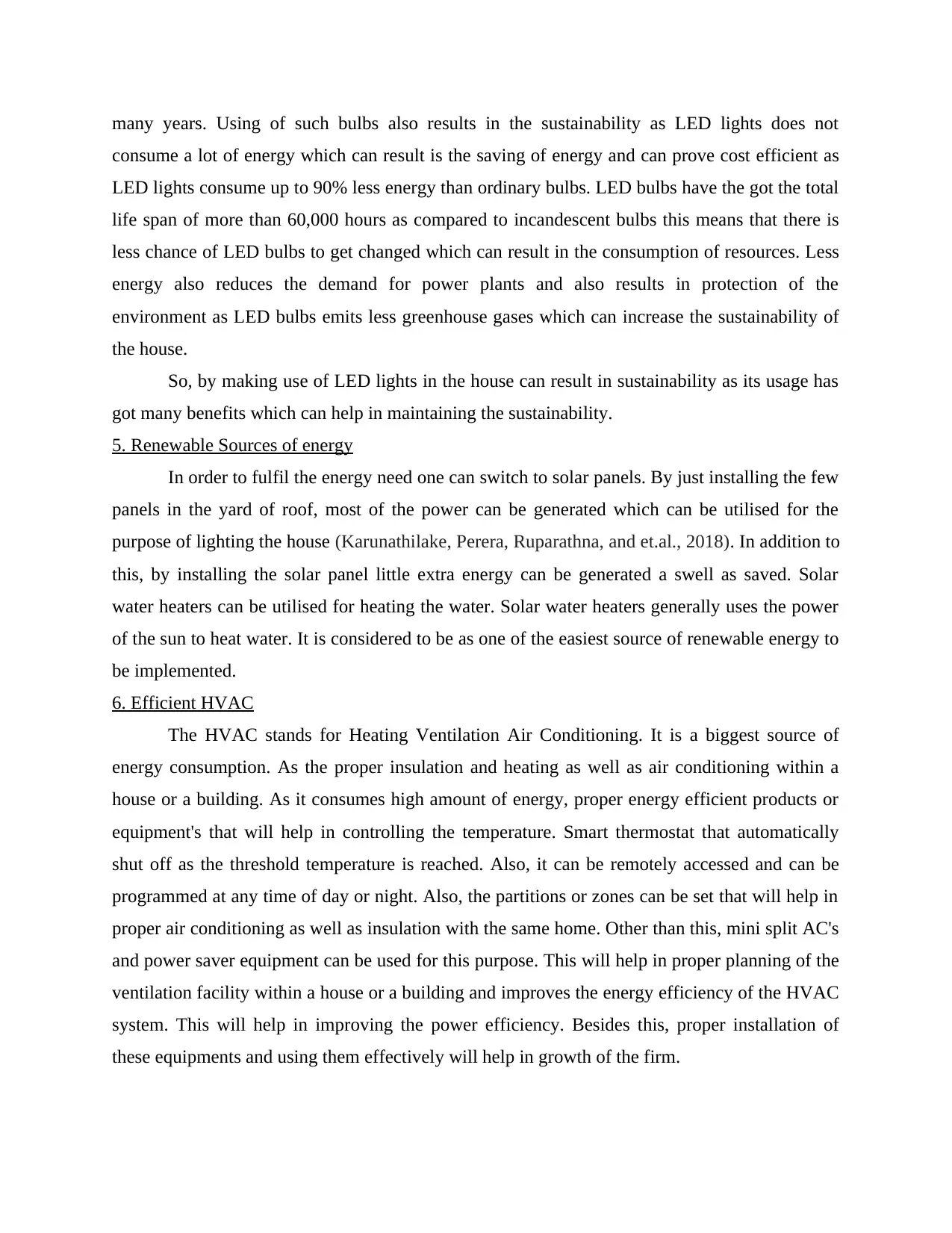
many years. Using of such bulbs also results in the sustainability as LED lights does not
consume a lot of energy which can result is the saving of energy and can prove cost efficient as
LED lights consume up to 90% less energy than ordinary bulbs. LED bulbs have the got the total
life span of more than 60,000 hours as compared to incandescent bulbs this means that there is
less chance of LED bulbs to get changed which can result in the consumption of resources. Less
energy also reduces the demand for power plants and also results in protection of the
environment as LED bulbs emits less greenhouse gases which can increase the sustainability of
the house.
So, by making use of LED lights in the house can result in sustainability as its usage has
got many benefits which can help in maintaining the sustainability.
5. Renewable Sources of energy
In order to fulfil the energy need one can switch to solar panels. By just installing the few
panels in the yard of roof, most of the power can be generated which can be utilised for the
purpose of lighting the house (Karunathilake, Perera, Ruparathna, and et.al., 2018). In addition to
this, by installing the solar panel little extra energy can be generated a swell as saved. Solar
water heaters can be utilised for heating the water. Solar water heaters generally uses the power
of the sun to heat water. It is considered to be as one of the easiest source of renewable energy to
be implemented.
6. Efficient HVAC
The HVAC stands for Heating Ventilation Air Conditioning. It is a biggest source of
energy consumption. As the proper insulation and heating as well as air conditioning within a
house or a building. As it consumes high amount of energy, proper energy efficient products or
equipment's that will help in controlling the temperature. Smart thermostat that automatically
shut off as the threshold temperature is reached. Also, it can be remotely accessed and can be
programmed at any time of day or night. Also, the partitions or zones can be set that will help in
proper air conditioning as well as insulation with the same home. Other than this, mini split AC's
and power saver equipment can be used for this purpose. This will help in proper planning of the
ventilation facility within a house or a building and improves the energy efficiency of the HVAC
system. This will help in improving the power efficiency. Besides this, proper installation of
these equipments and using them effectively will help in growth of the firm.
consume a lot of energy which can result is the saving of energy and can prove cost efficient as
LED lights consume up to 90% less energy than ordinary bulbs. LED bulbs have the got the total
life span of more than 60,000 hours as compared to incandescent bulbs this means that there is
less chance of LED bulbs to get changed which can result in the consumption of resources. Less
energy also reduces the demand for power plants and also results in protection of the
environment as LED bulbs emits less greenhouse gases which can increase the sustainability of
the house.
So, by making use of LED lights in the house can result in sustainability as its usage has
got many benefits which can help in maintaining the sustainability.
5. Renewable Sources of energy
In order to fulfil the energy need one can switch to solar panels. By just installing the few
panels in the yard of roof, most of the power can be generated which can be utilised for the
purpose of lighting the house (Karunathilake, Perera, Ruparathna, and et.al., 2018). In addition to
this, by installing the solar panel little extra energy can be generated a swell as saved. Solar
water heaters can be utilised for heating the water. Solar water heaters generally uses the power
of the sun to heat water. It is considered to be as one of the easiest source of renewable energy to
be implemented.
6. Efficient HVAC
The HVAC stands for Heating Ventilation Air Conditioning. It is a biggest source of
energy consumption. As the proper insulation and heating as well as air conditioning within a
house or a building. As it consumes high amount of energy, proper energy efficient products or
equipment's that will help in controlling the temperature. Smart thermostat that automatically
shut off as the threshold temperature is reached. Also, it can be remotely accessed and can be
programmed at any time of day or night. Also, the partitions or zones can be set that will help in
proper air conditioning as well as insulation with the same home. Other than this, mini split AC's
and power saver equipment can be used for this purpose. This will help in proper planning of the
ventilation facility within a house or a building and improves the energy efficiency of the HVAC
system. This will help in improving the power efficiency. Besides this, proper installation of
these equipments and using them effectively will help in growth of the firm.
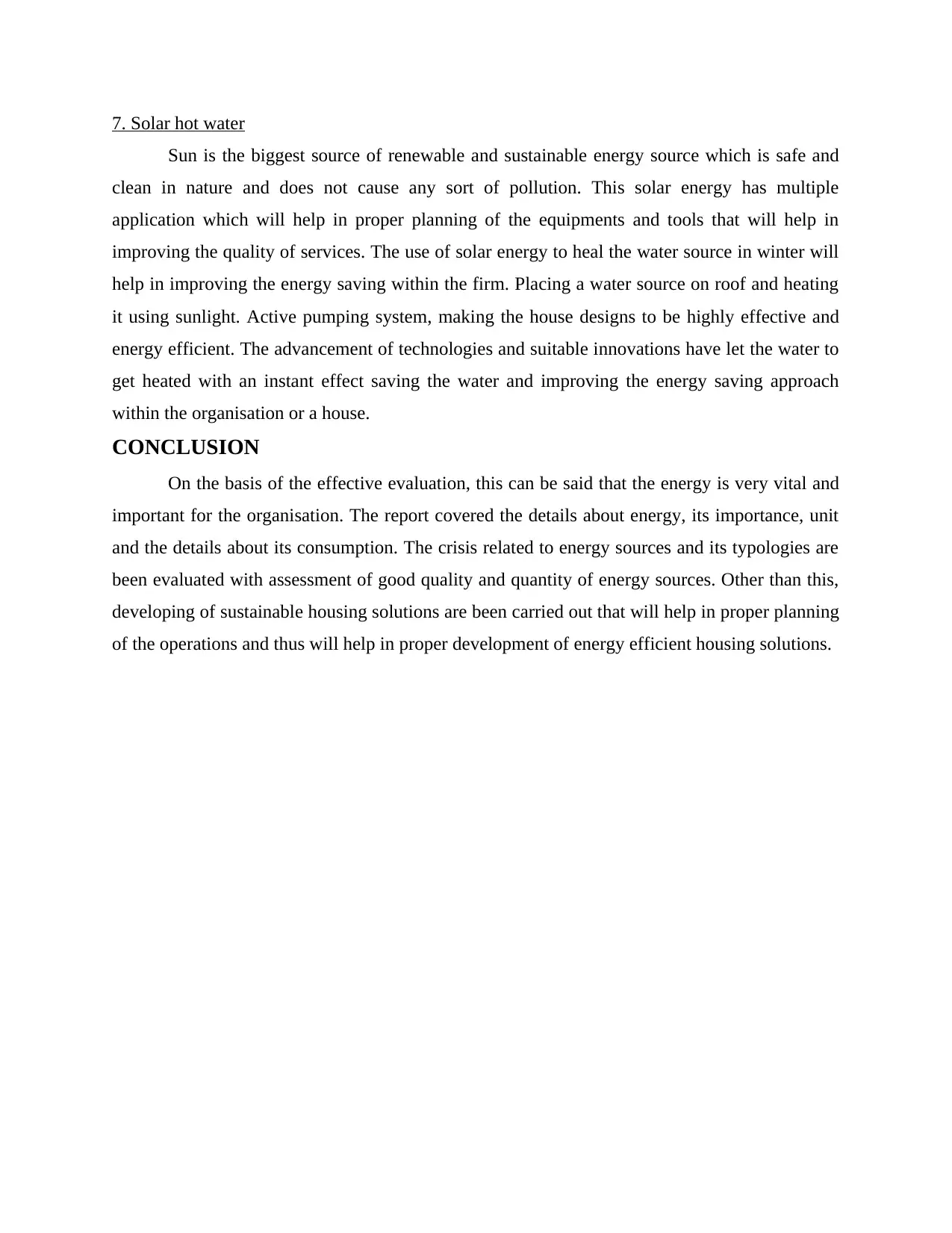
7. Solar hot water
Sun is the biggest source of renewable and sustainable energy source which is safe and
clean in nature and does not cause any sort of pollution. This solar energy has multiple
application which will help in proper planning of the equipments and tools that will help in
improving the quality of services. The use of solar energy to heal the water source in winter will
help in improving the energy saving within the firm. Placing a water source on roof and heating
it using sunlight. Active pumping system, making the house designs to be highly effective and
energy efficient. The advancement of technologies and suitable innovations have let the water to
get heated with an instant effect saving the water and improving the energy saving approach
within the organisation or a house.
CONCLUSION
On the basis of the effective evaluation, this can be said that the energy is very vital and
important for the organisation. The report covered the details about energy, its importance, unit
and the details about its consumption. The crisis related to energy sources and its typologies are
been evaluated with assessment of good quality and quantity of energy sources. Other than this,
developing of sustainable housing solutions are been carried out that will help in proper planning
of the operations and thus will help in proper development of energy efficient housing solutions.
Sun is the biggest source of renewable and sustainable energy source which is safe and
clean in nature and does not cause any sort of pollution. This solar energy has multiple
application which will help in proper planning of the equipments and tools that will help in
improving the quality of services. The use of solar energy to heal the water source in winter will
help in improving the energy saving within the firm. Placing a water source on roof and heating
it using sunlight. Active pumping system, making the house designs to be highly effective and
energy efficient. The advancement of technologies and suitable innovations have let the water to
get heated with an instant effect saving the water and improving the energy saving approach
within the organisation or a house.
CONCLUSION
On the basis of the effective evaluation, this can be said that the energy is very vital and
important for the organisation. The report covered the details about energy, its importance, unit
and the details about its consumption. The crisis related to energy sources and its typologies are
been evaluated with assessment of good quality and quantity of energy sources. Other than this,
developing of sustainable housing solutions are been carried out that will help in proper planning
of the operations and thus will help in proper development of energy efficient housing solutions.
Paraphrase This Document
Need a fresh take? Get an instant paraphrase of this document with our AI Paraphraser

REFERENCES
Books and Jornals
Chu, S., Cui, Y. and Liu, N., 2017. The path towards sustainable energy. Nature materials. 16(1).
p.16.
Cuce, E., Harjunowibowo, D. and Cuce, P. M., 2016. Renewable and sustainable energy saving
strategies for greenhouse systems: A comprehensive review. Renewable and
Sustainable Energy Reviews. 64. pp.34-59.
Dusastre, V. and Martiradonna, L., 2017. Materials for sustainable energy.
Fontes, C.H.D.O. and Freires, F.G.M., 2018. Sustainable and renewable energy supply chain: A
system dynamics overview. Renewable and Sustainable Energy Reviews.82. pp.247-
259.
Guerra-Santin, O., Klein, T. and Silvester, S.J.E.E., 2018. Considering user profiles and
occupants’ behaviour on a zero energy renovation strategy for multi-family housing in
the Netherlands. Energy Efficiency.11(7). pp.1847-1870.
Karunathilake, H., Perera, P., Ruparathna, R., and et.al.,. Renewable energy integration into
community energy systems: A case study of new urban residential
development. Journal of Cleaner Production.173. pp.292-307.
Li, S and et.al., 2017. Sustainable energy source for wearable electronics based on multilayer
elastomeric triboelectric nanogenerators. Advanced Energy Materials. 7(13).
p.1602832.
Liu, G., Liu, X., and Liu, Z., 2019. Near-unity, full-spectrum, nanoscale solar absorbers and
near-perfect blackbody emitters. Solar Energy Materials and Solar Cells. 190. pp.20-
29.
Luthra, S and et.al., 2015. Barriers to renewable/sustainable energy technologies adoption: Indian
perspective. Renewable and sustainable energy reviews. 41 pp.762-776.
Ng, K. C. and Shahzad, M. W., 2018. Sustainable desalination using ocean thermocline
energy.Renewable and Sustainable Energy Reviews. 82. pp.240-246.
Books and Jornals
Chu, S., Cui, Y. and Liu, N., 2017. The path towards sustainable energy. Nature materials. 16(1).
p.16.
Cuce, E., Harjunowibowo, D. and Cuce, P. M., 2016. Renewable and sustainable energy saving
strategies for greenhouse systems: A comprehensive review. Renewable and
Sustainable Energy Reviews. 64. pp.34-59.
Dusastre, V. and Martiradonna, L., 2017. Materials for sustainable energy.
Fontes, C.H.D.O. and Freires, F.G.M., 2018. Sustainable and renewable energy supply chain: A
system dynamics overview. Renewable and Sustainable Energy Reviews.82. pp.247-
259.
Guerra-Santin, O., Klein, T. and Silvester, S.J.E.E., 2018. Considering user profiles and
occupants’ behaviour on a zero energy renovation strategy for multi-family housing in
the Netherlands. Energy Efficiency.11(7). pp.1847-1870.
Karunathilake, H., Perera, P., Ruparathna, R., and et.al.,. Renewable energy integration into
community energy systems: A case study of new urban residential
development. Journal of Cleaner Production.173. pp.292-307.
Li, S and et.al., 2017. Sustainable energy source for wearable electronics based on multilayer
elastomeric triboelectric nanogenerators. Advanced Energy Materials. 7(13).
p.1602832.
Liu, G., Liu, X., and Liu, Z., 2019. Near-unity, full-spectrum, nanoscale solar absorbers and
near-perfect blackbody emitters. Solar Energy Materials and Solar Cells. 190. pp.20-
29.
Luthra, S and et.al., 2015. Barriers to renewable/sustainable energy technologies adoption: Indian
perspective. Renewable and sustainable energy reviews. 41 pp.762-776.
Ng, K. C. and Shahzad, M. W., 2018. Sustainable desalination using ocean thermocline
energy.Renewable and Sustainable Energy Reviews. 82. pp.240-246.
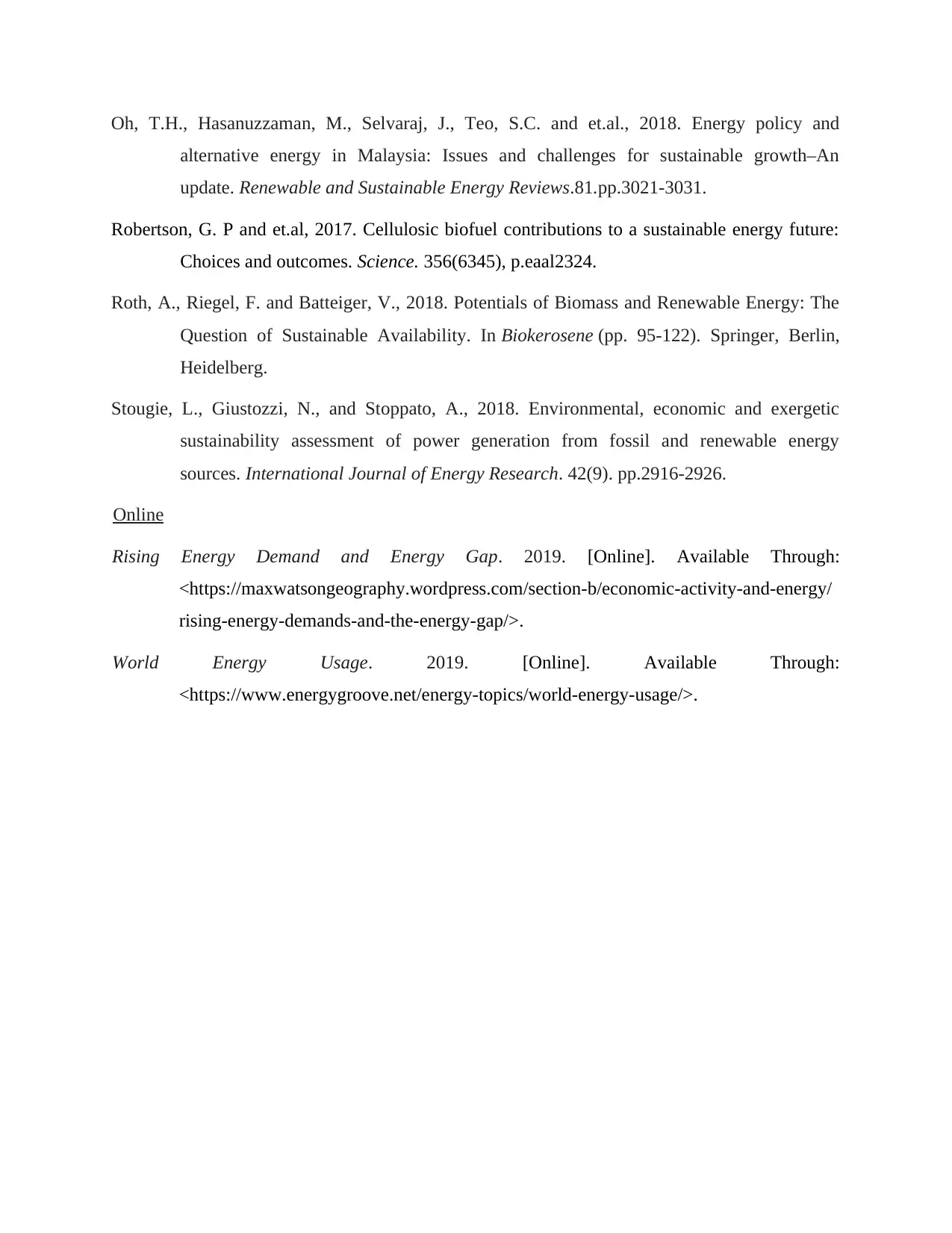
Oh, T.H., Hasanuzzaman, M., Selvaraj, J., Teo, S.C. and et.al., 2018. Energy policy and
alternative energy in Malaysia: Issues and challenges for sustainable growth–An
update. Renewable and Sustainable Energy Reviews.81.pp.3021-3031.
Robertson, G. P and et.al, 2017. Cellulosic biofuel contributions to a sustainable energy future:
Choices and outcomes. Science. 356(6345), p.eaal2324.
Roth, A., Riegel, F. and Batteiger, V., 2018. Potentials of Biomass and Renewable Energy: The
Question of Sustainable Availability. In Biokerosene (pp. 95-122). Springer, Berlin,
Heidelberg.
Stougie, L., Giustozzi, N., and Stoppato, A., 2018. Environmental, economic and exergetic
sustainability assessment of power generation from fossil and renewable energy
sources. International Journal of Energy Research. 42(9). pp.2916-2926.
Online
Rising Energy Demand and Energy Gap. 2019. [Online]. Available Through:
<https://maxwatsongeography.wordpress.com/section-b/economic-activity-and-energy/
rising-energy-demands-and-the-energy-gap/>.
World Energy Usage. 2019. [Online]. Available Through:
<https://www.energygroove.net/energy-topics/world-energy-usage/>.
alternative energy in Malaysia: Issues and challenges for sustainable growth–An
update. Renewable and Sustainable Energy Reviews.81.pp.3021-3031.
Robertson, G. P and et.al, 2017. Cellulosic biofuel contributions to a sustainable energy future:
Choices and outcomes. Science. 356(6345), p.eaal2324.
Roth, A., Riegel, F. and Batteiger, V., 2018. Potentials of Biomass and Renewable Energy: The
Question of Sustainable Availability. In Biokerosene (pp. 95-122). Springer, Berlin,
Heidelberg.
Stougie, L., Giustozzi, N., and Stoppato, A., 2018. Environmental, economic and exergetic
sustainability assessment of power generation from fossil and renewable energy
sources. International Journal of Energy Research. 42(9). pp.2916-2926.
Online
Rising Energy Demand and Energy Gap. 2019. [Online]. Available Through:
<https://maxwatsongeography.wordpress.com/section-b/economic-activity-and-energy/
rising-energy-demands-and-the-energy-gap/>.
World Energy Usage. 2019. [Online]. Available Through:
<https://www.energygroove.net/energy-topics/world-energy-usage/>.
1 out of 15
Related Documents
Your All-in-One AI-Powered Toolkit for Academic Success.
+13062052269
info@desklib.com
Available 24*7 on WhatsApp / Email
![[object Object]](/_next/static/media/star-bottom.7253800d.svg)
Unlock your academic potential
© 2024 | Zucol Services PVT LTD | All rights reserved.





